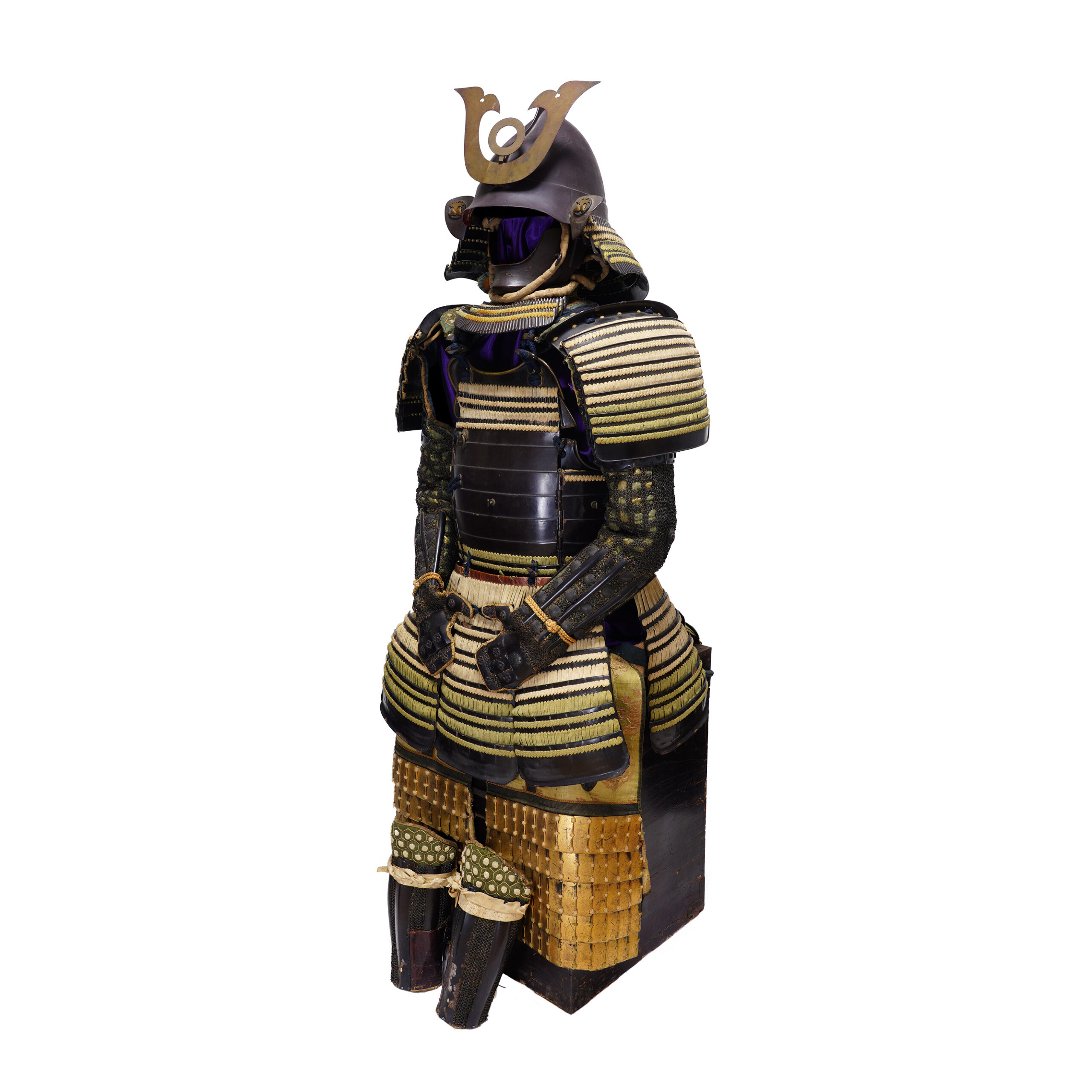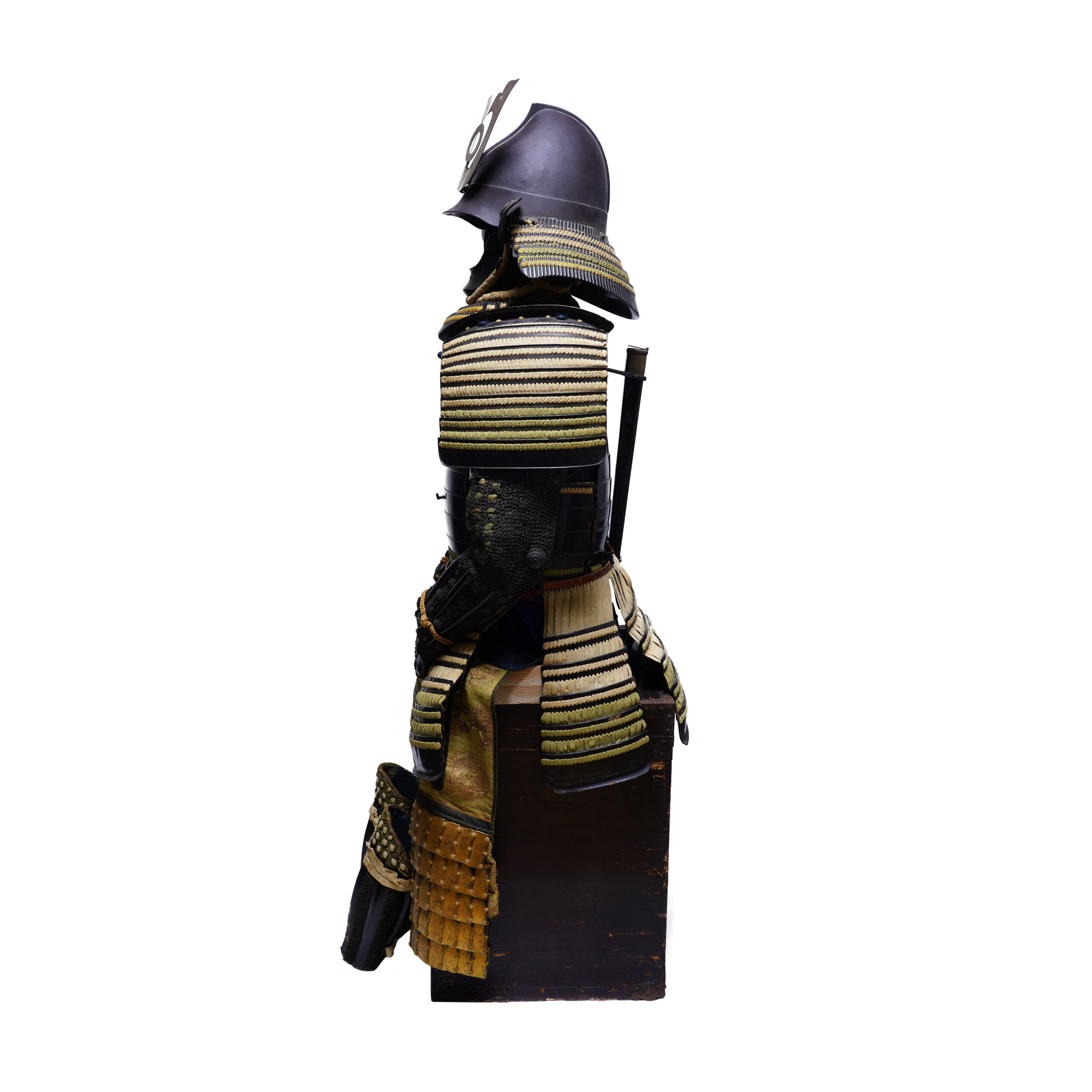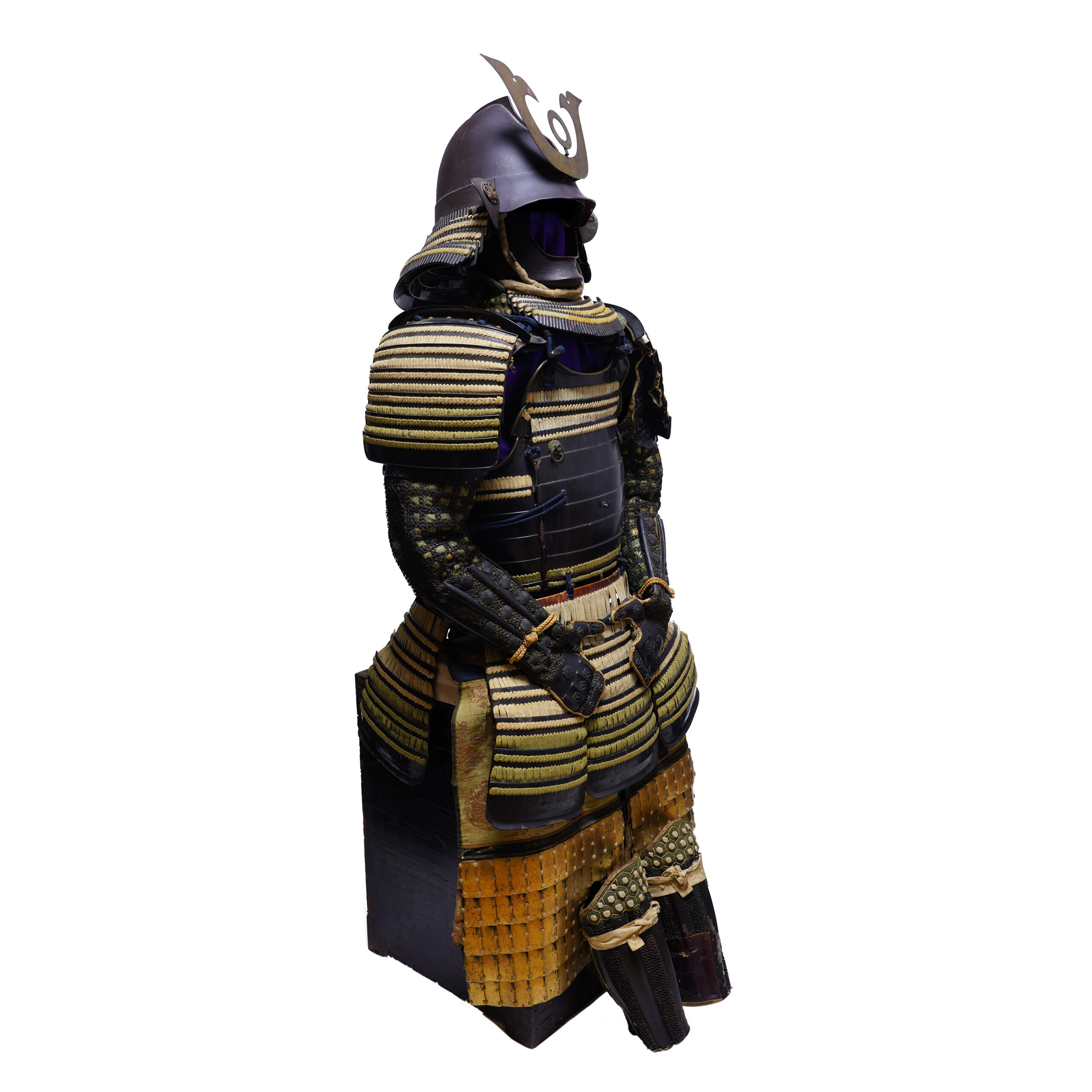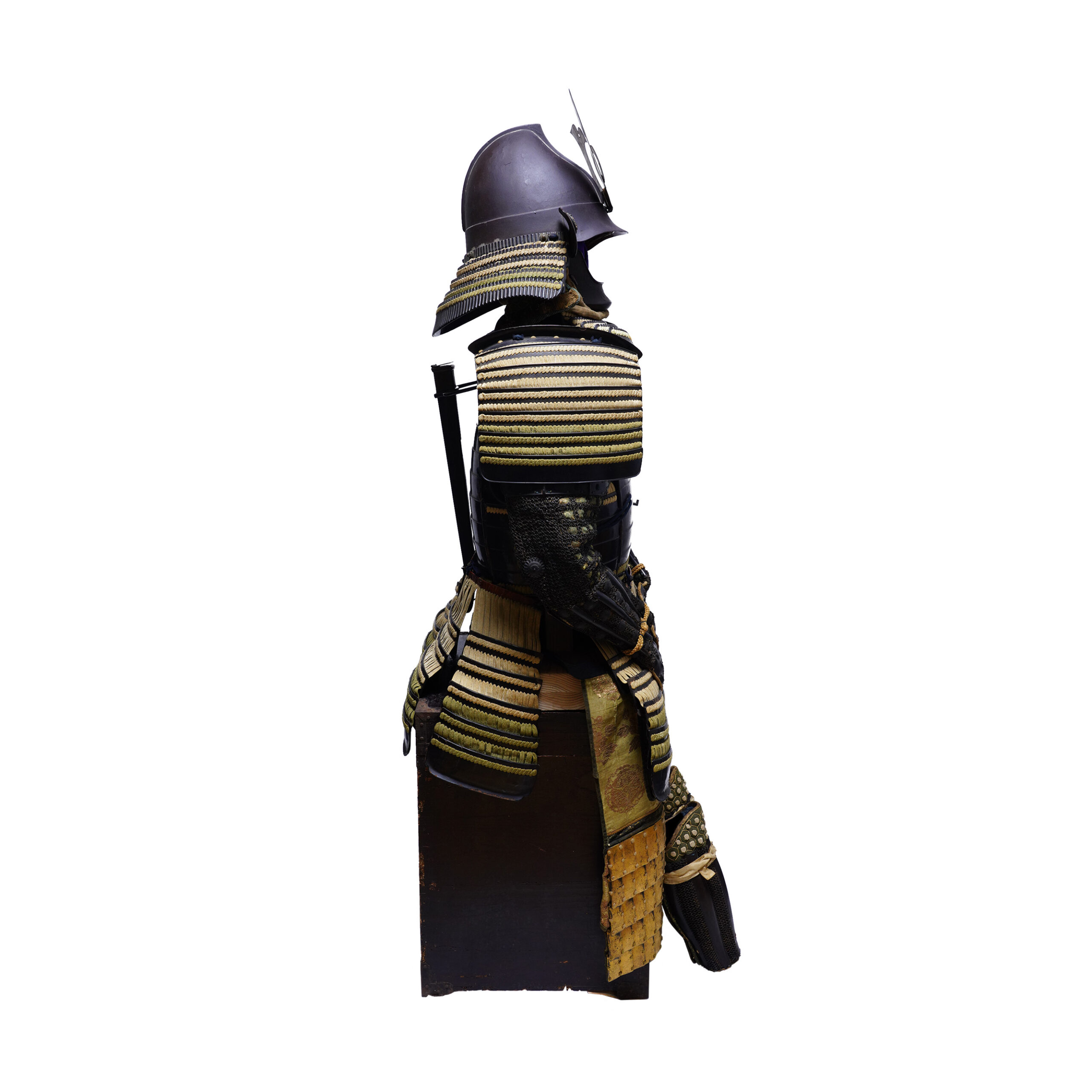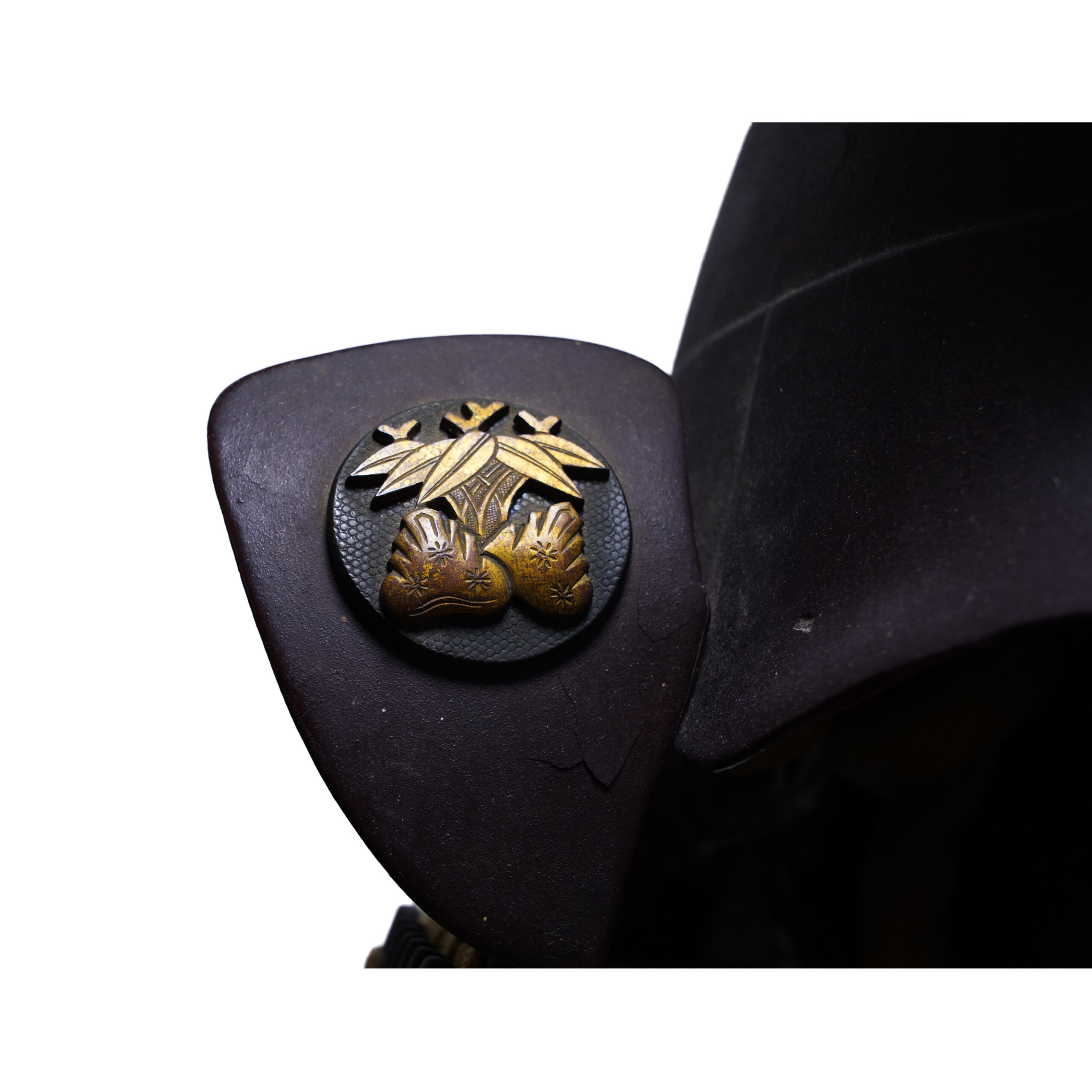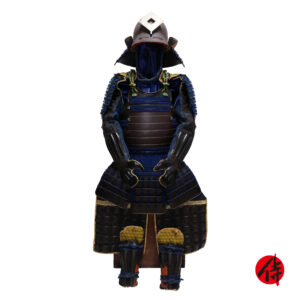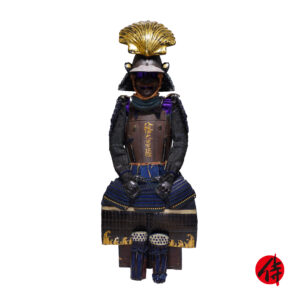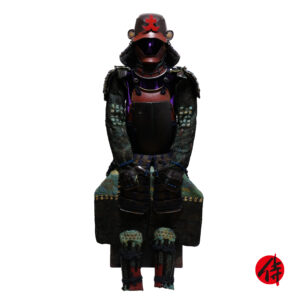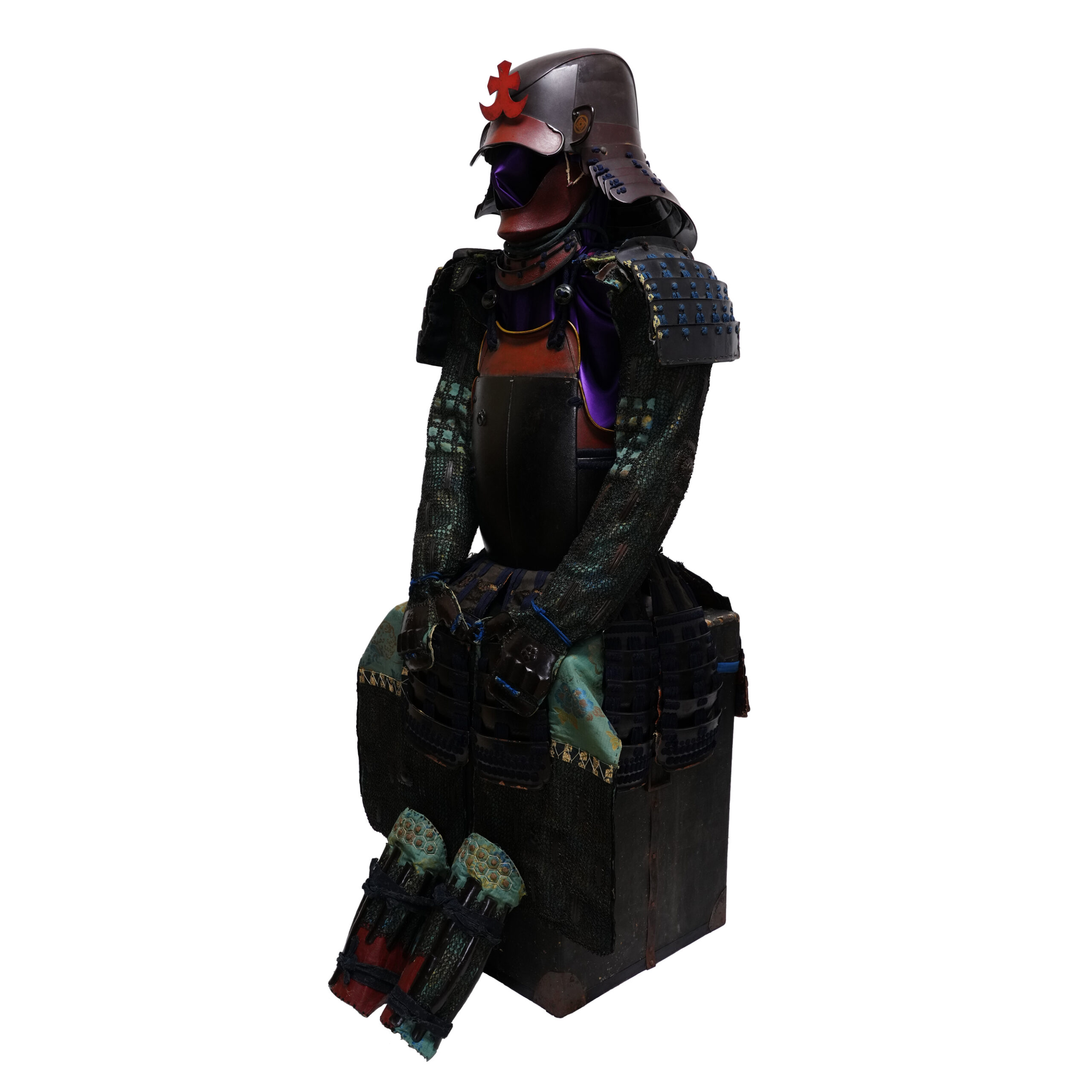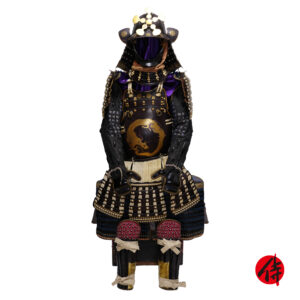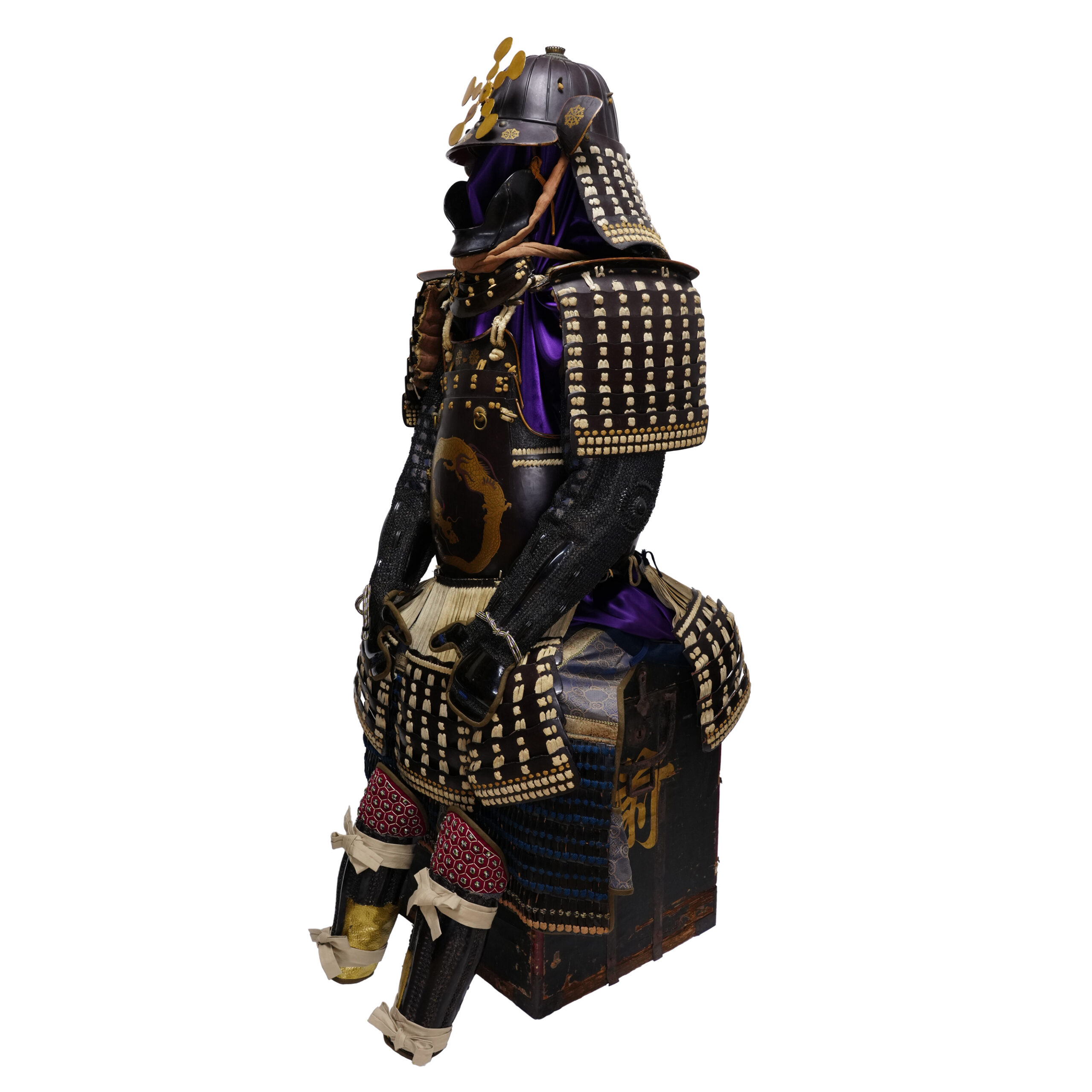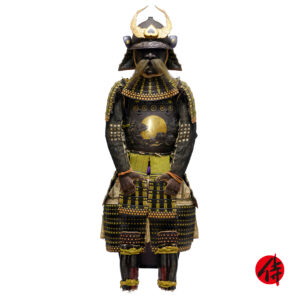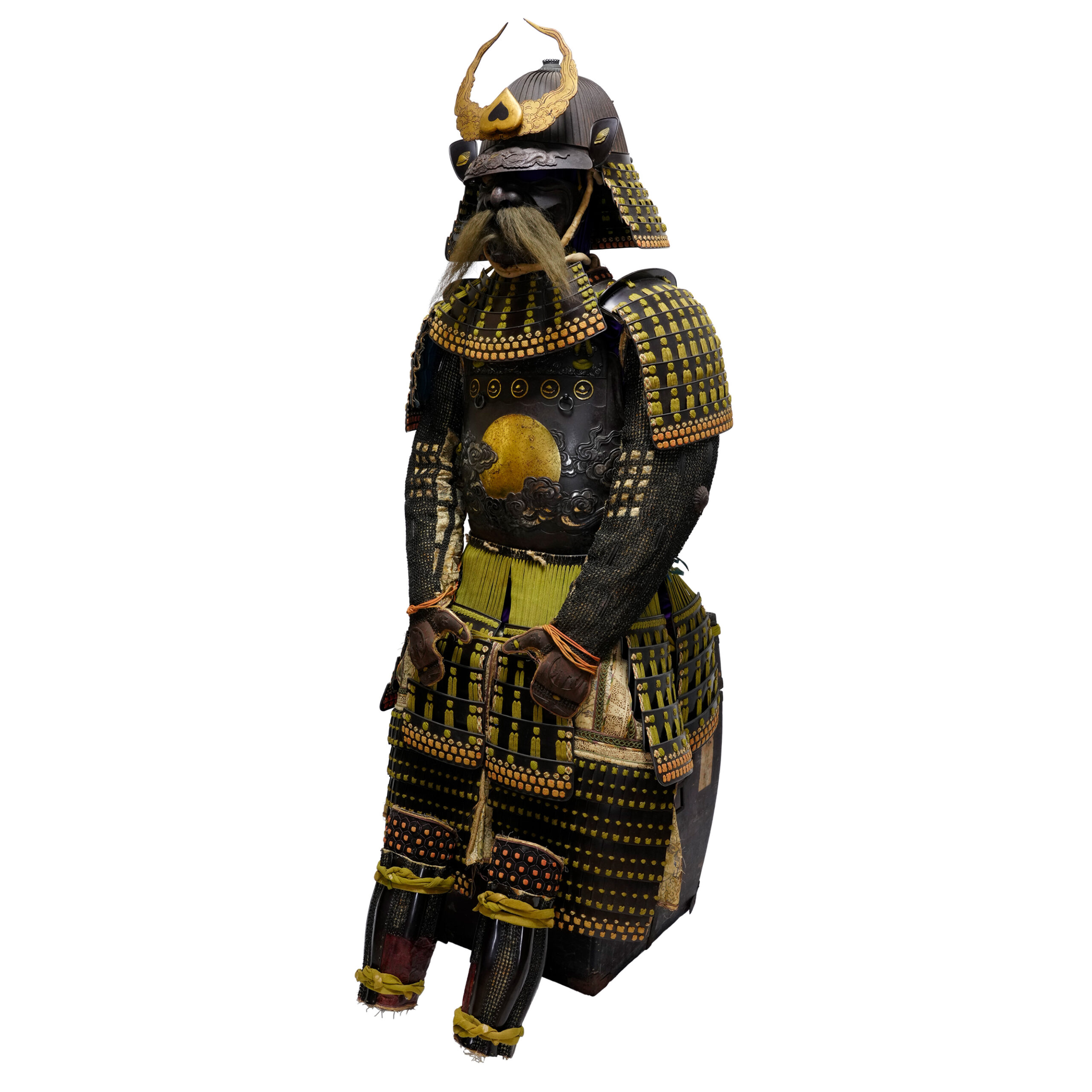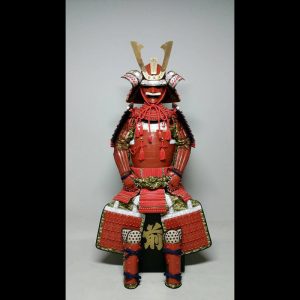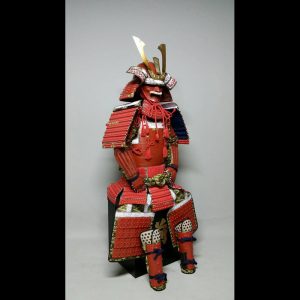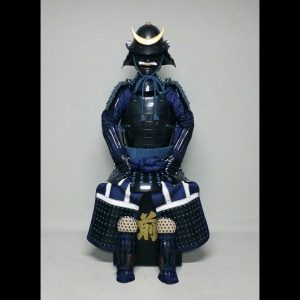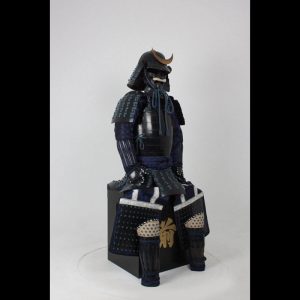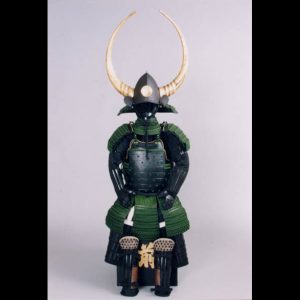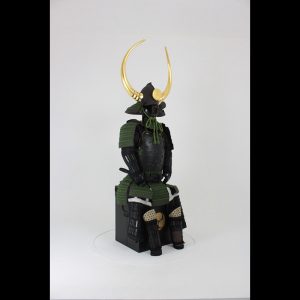Antique Edo Period Samurai Armor with Tokubetsu Kicho Certificate (A-23)
Period: Mid Edo Period
appraised by The Association for the Research and Preservation of Japanese Helmets and Armor
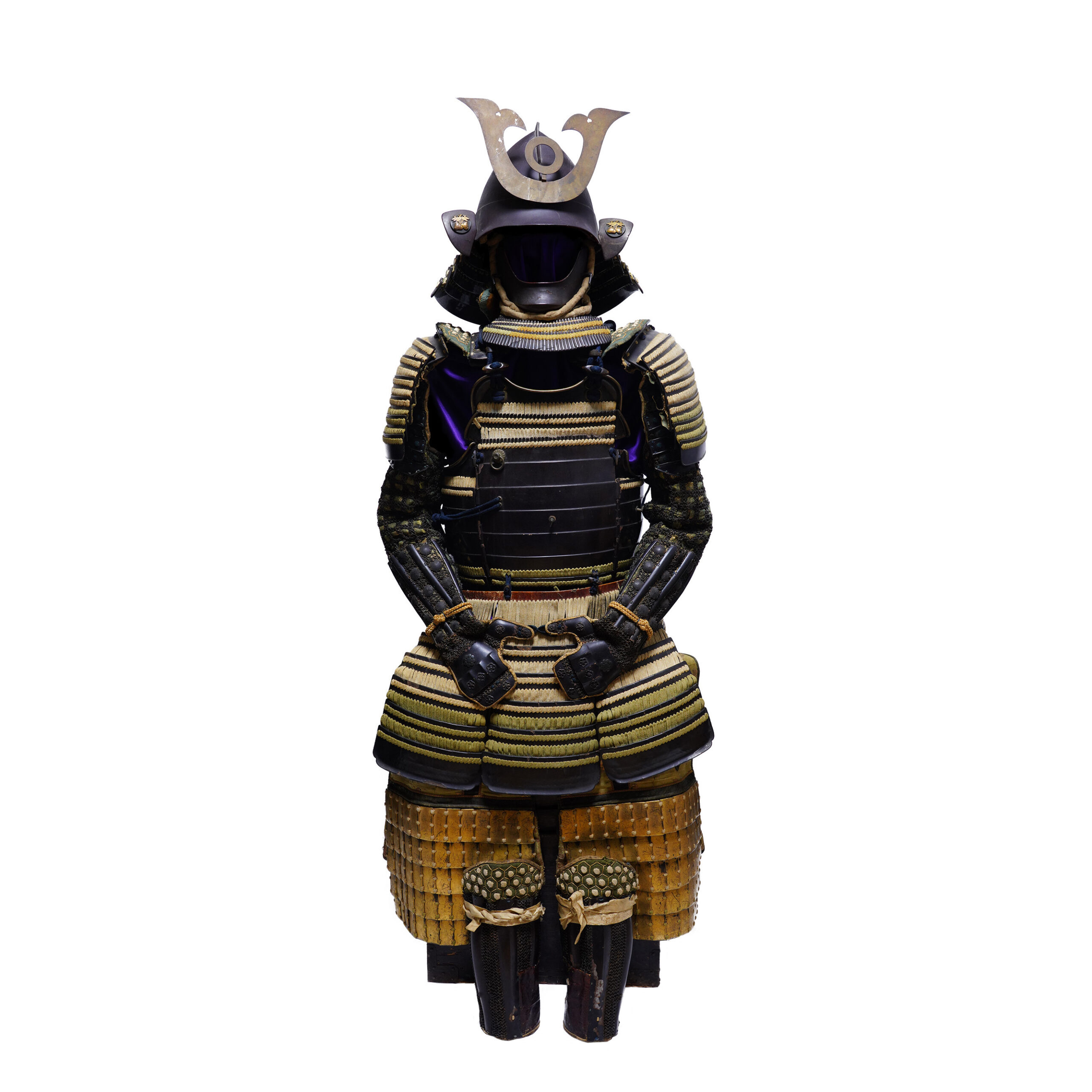
Kabuto (helmet)
■Helmet bowl: Momonari Kabuto
The Kabuto (兜, helmet) is a protector for the head. When people started using the Kabuto, it was initially designed for practical use. However, the principal purpose of its design has changed with time; Samurai tried to express their dignity, personality, or religion by wearing the characteristic designed Kabutos. According to a theory, these unique designed Kabutos were made from the late Muromachi (室町, 1467-1573) period to the Edo (江戸, 1603-1868) period. This type of Kabuto is categorized as the Kawari Kabuto (変わり兜), and a variety of materials were used to create them. For example, animal fur, seashells, plants, and papers were used as materials for decoration.
We believe this Kabuto is categorized as the Momonari Kabuto (桃形兜). The characteristic of this style of Kabuto is that the top of its head has a peach shape (peach is called Momo in Japanese). The Momonari Kabuto is a kind of Kawari Kabuto. Compared to the Suji Kabuto (筋兜), the Momonari Kabuto took less time and effort and was suitable for mass production. Therefore, in the beginning, mainly lower-ranked Samurai warriors wore this style of Kabutos as their simple protector. However, after a while, people valued the functionality and beauty of its shape. And even some high-ranked Samurai regularly used the Momonari Kabutos. The smooth surface was expected to deflect attacks from swords, spears, and ammunition and reduce the damage received. In addition, the Momonari Kabuto is relatively light. We think it is also one of the reasons why many Samurai warriors accepted it.
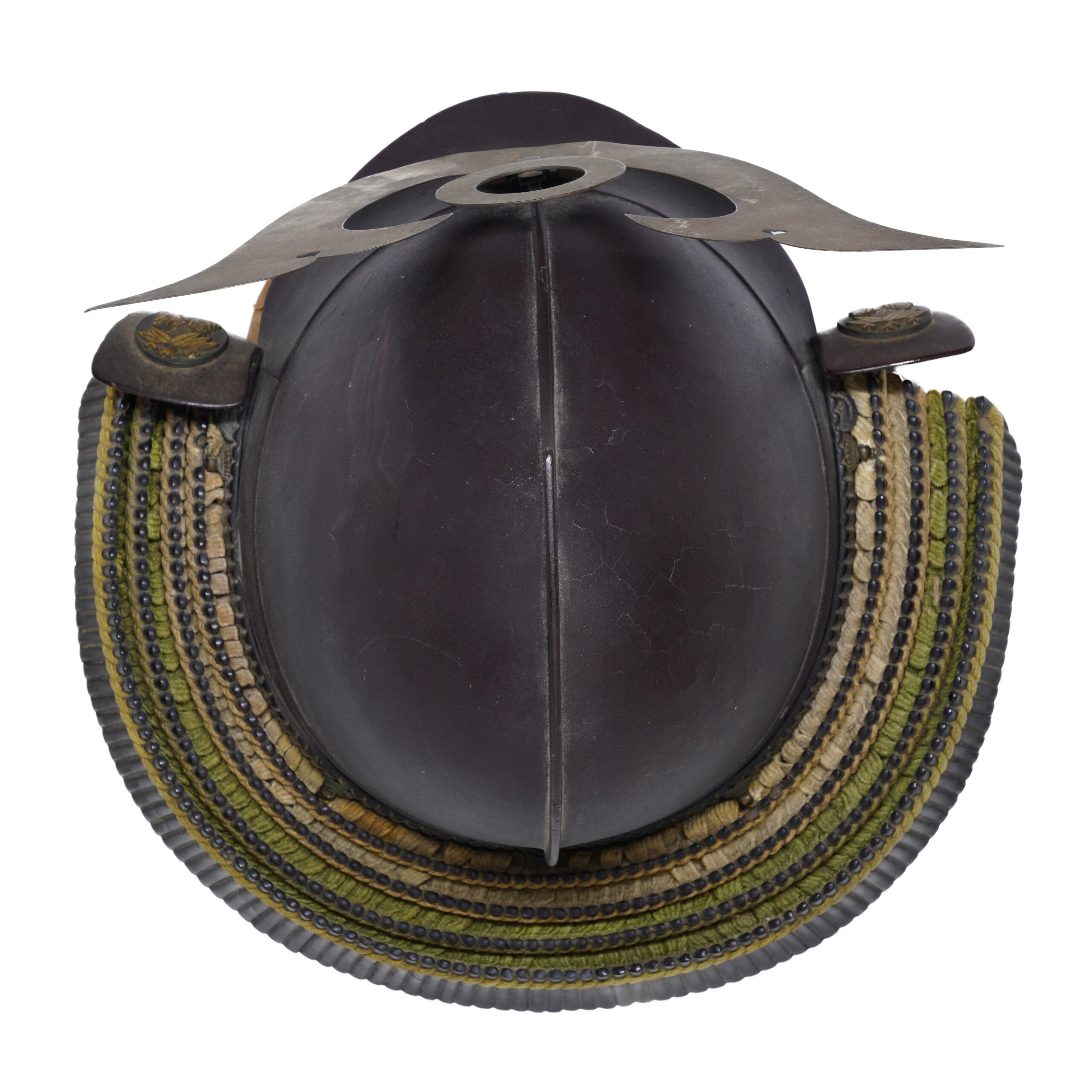
■Shikoro (side neck guard):
Iron plates laced with ivory and green threads.
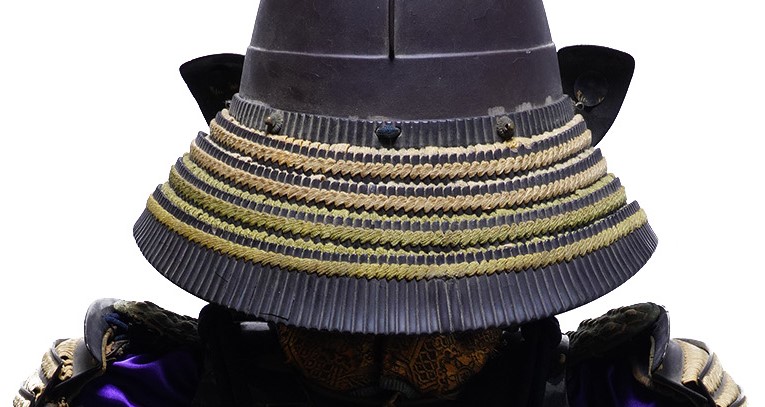
■Fukikaeshi (side neck guard): Sasa Mon
The Fukikaeshi (吹き返し) is both ends of a Kabuto. It protects the face from swords and also shows its beautiful workmanship. Family crests are sometimes designed on this part, as seen in this work. You would find a golden plant crest on the Fukikaeshi part. We think this motif is the Sasa (笹, bamboo grass). The upper part of this crest is bamboo grasses, and the lower part seems to be a clump of short grasses covering the base of the bamboo grasses. Bamboos grow neatly towards the sky, and it is vital so that this motif represents nobility and strength. Besides, the bamboo breaks straight, but its content is hollow; people thought it showed innocence. According to a foreign legend, the Houhou (鳳凰, Fenghuang) eats bamboo fruits; therefore, bamboo has been considered a sacred plant. Also, as it keeps its green color even in cold winter, people thought the bamboo pattern represented eternity and longevity.
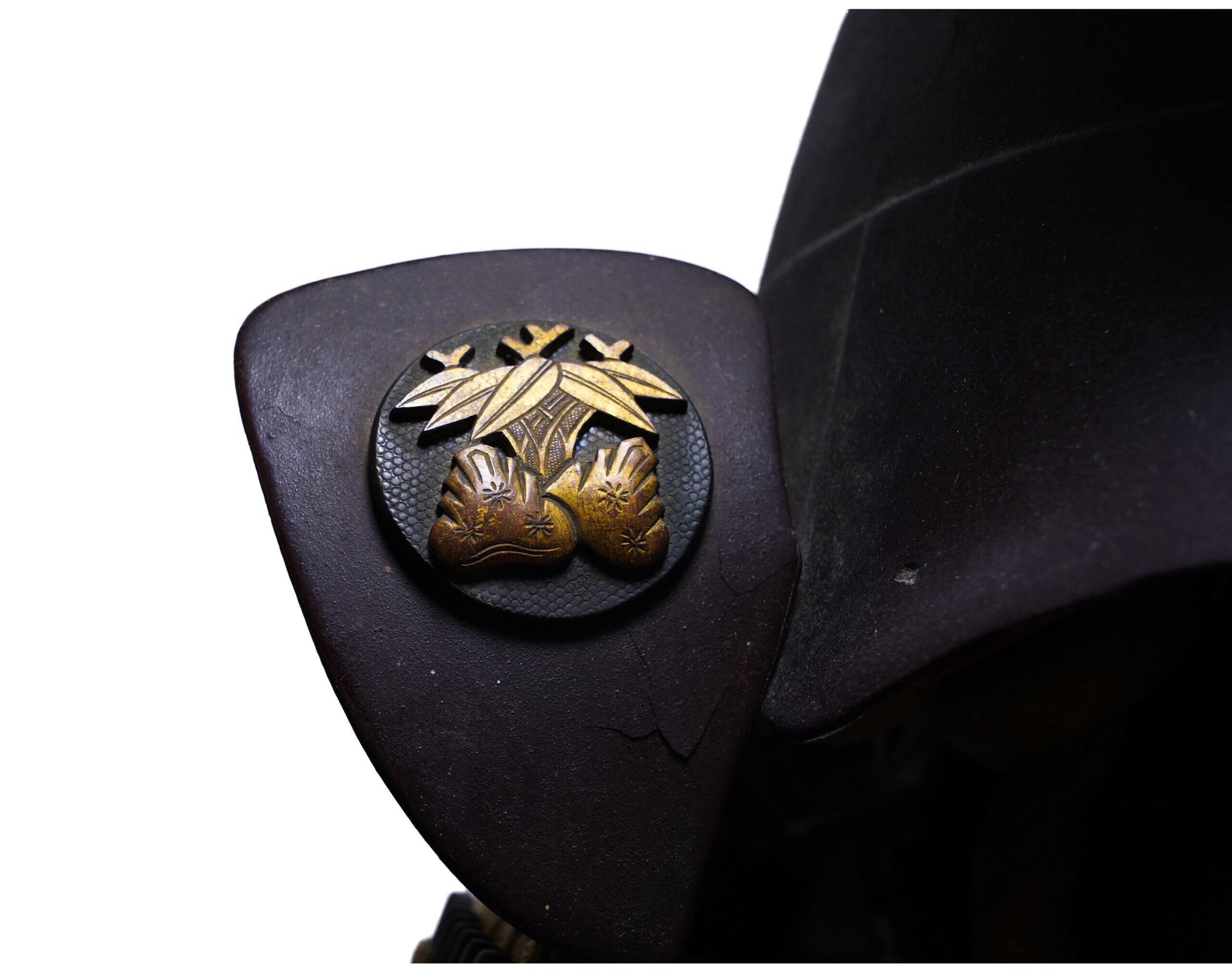
■Menpo (face guard): Hanbō
This type of half mask is called the Hanbō (半頬) and was popular as it was easy to breathe compared to the full mask that covers his nose. The purpose of Menpo was not only to protect Samurai’s face. But also to hide their true faces so that their psychological states were not affected.
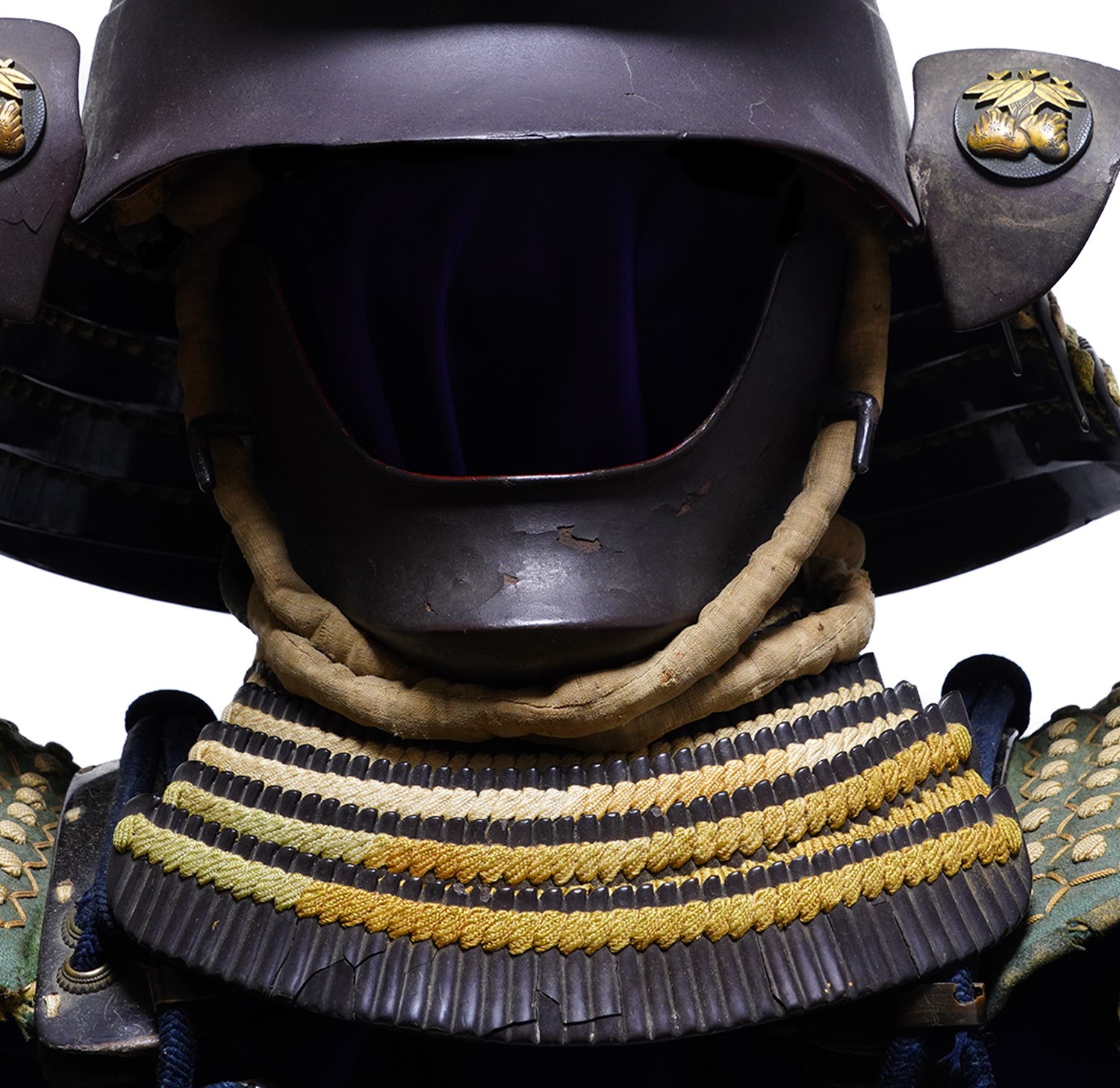
■ Kuwagata (Front decoration): Nichirin
The Kuwagata (鍬形) is attached to this Kabuto. It is a kind of Maedatemono (前立物, front decoration) to dignify the appearance. This helmet’s Kuwagata has a shape in which its tip is bifurcated. It is made of one metal plate and has a simple look. Although there are minor damages, such as scratches, these are traces of its long history. We hope you will enjoy it as an antique texture. In addition, the Inome (猪の目, boar’s eye) patten is engraved at the tip of each end of Kuwagata. The Inome pattern has been used since ancient times and looks similar to the heart mark. Some people believed the Inome design would work as an amulet to protect them from evil spirits or fire. Also, it is said it would bring good luck.
The Maedatemono (前立物, front decoration) is attached to this Kabuto. We estimate the motif of Maetate is a Nichirin (日輪, another name for the sun) or a Getsurin/Gatsurin (月輪, another name for the moon). There was a widespread belief among Samurai, the Myouken (妙見) belief. This religion was born in India. It was mixed with the Polestar belief and was brought to Japan from the continent. The sun, the moon, and the stars of the entire universe were the symbols of faith. The Myouken Bosatsu (妙見菩薩, 菩薩 means Bodhisattva) fulfills all wishes such as fertility of rich harvest, peace, the prosperity of the clan, healing of illness, longevity, success in business, traffic safety, academic achievement, marriage, etcetera. So, it is understandable that Samurai cherished sun and moon motifs. The former owner of this armor might have shown his faith by wearing this Kabuto.
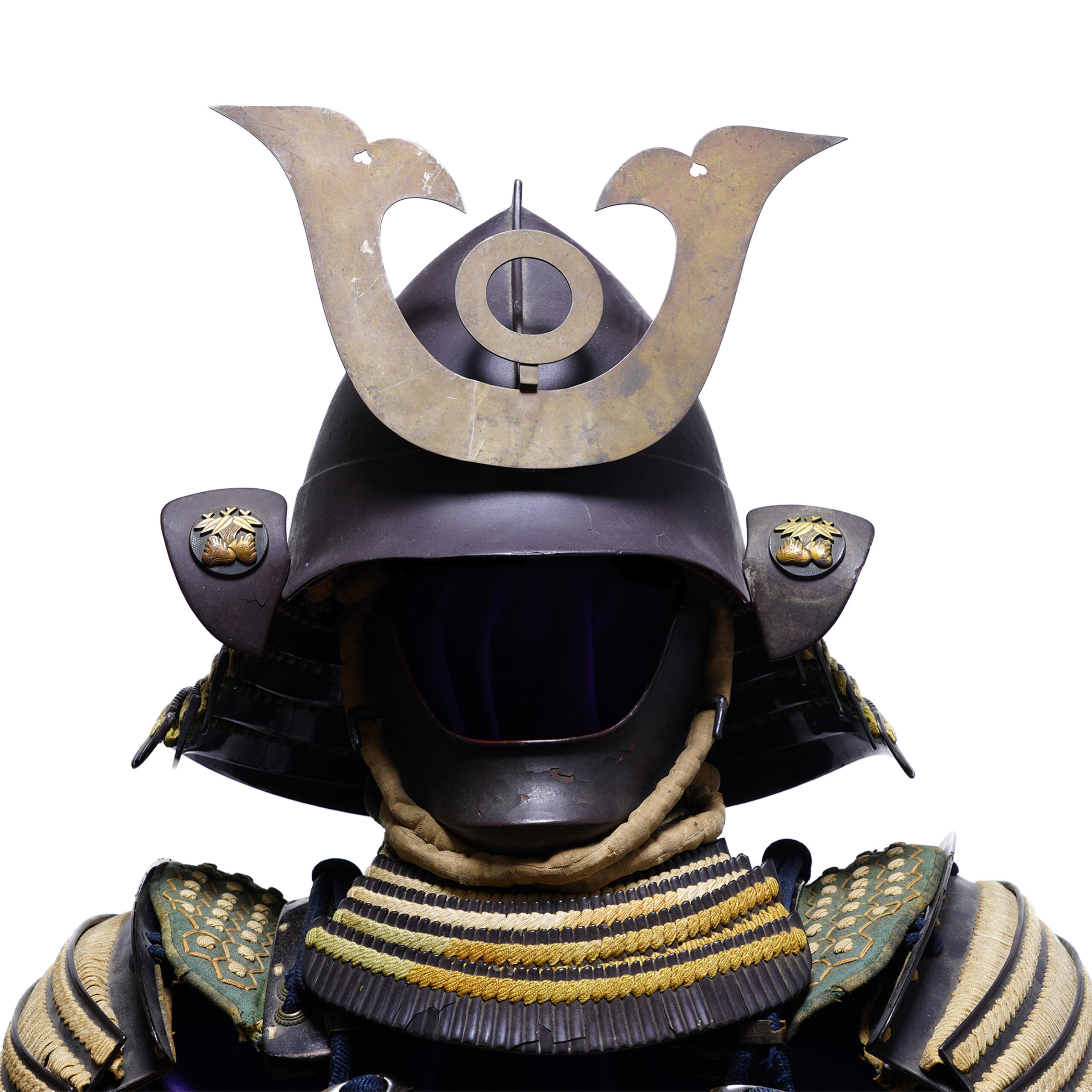
Armor
■Do (cuirass): Okegawa Nimai Do
Nimai Do (二枚胴) is a kind of cuirass for the Tousei Gusoku (当世具足, developed armor style). Nimai Do (二枚胴) was named because Nimai (二枚) means two plates, and Do (胴) means torso in Japanese. Instead of using a large number of small lamellar plates called Kozane (小札), this cuirass used large iron plates riveted.
The name Okegawa (桶側) came from the fact that the shape of this cuirass resembles the Gawa (側, side) of Oke (桶, Japanese wooden tub). The body armor part can be separated into two pieces and connected with a hinge. Generally, a hinge is located on the left side, and you could tighten a cuirass on the right side. The Okegawa Do was relatively easy to make and had high strength; therefore, it is said this style of cuirass became popular in the latter half of the Muromachi (室町, 1336-1573) period.
■Sode (shoulder guards):
Iron Sode (袖) laced with ivory and green threads.
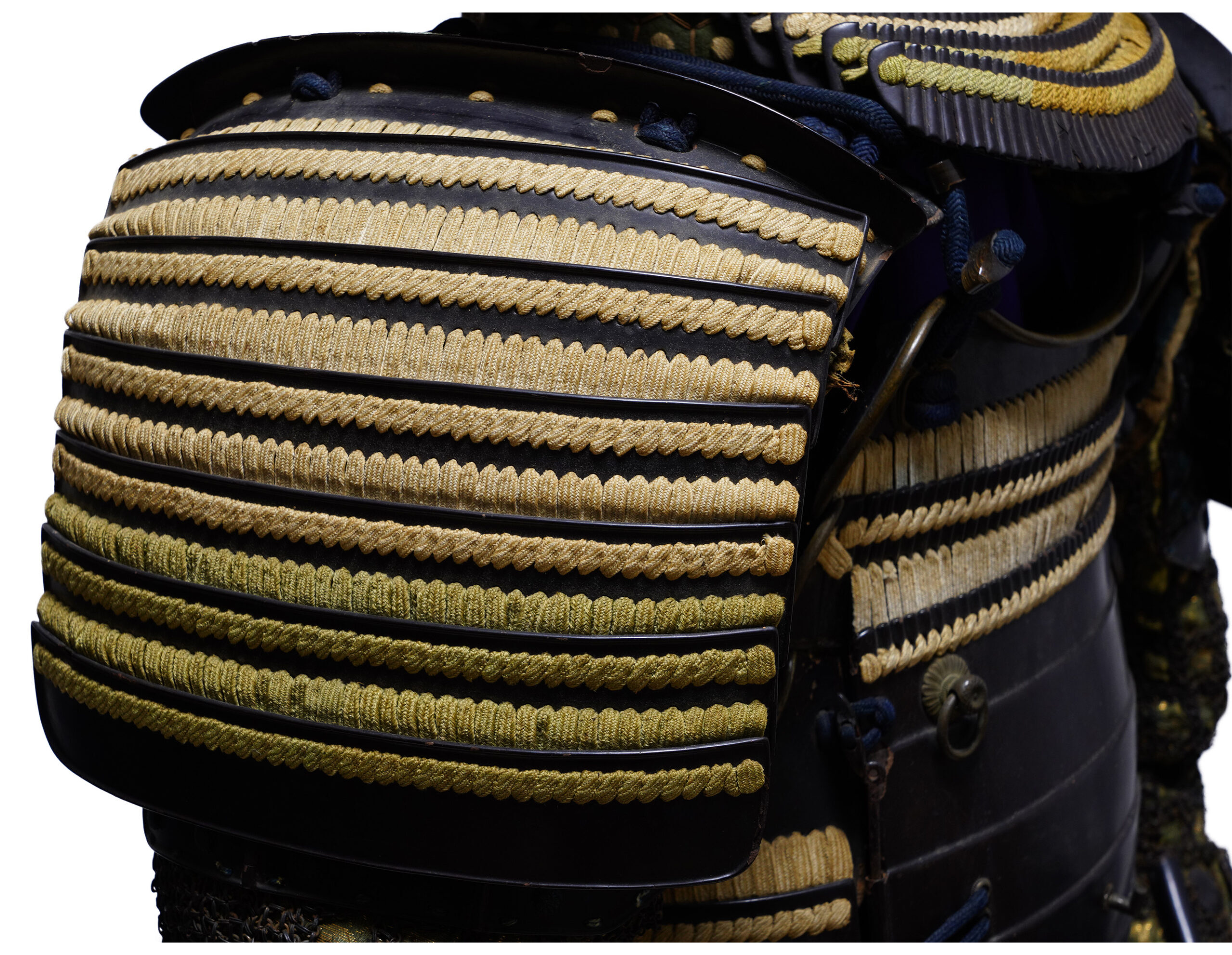
■Kusazuri (skirt of plates attached to the cuirass):
Lacquered iron Kusazuri laced with ivory and green threads.
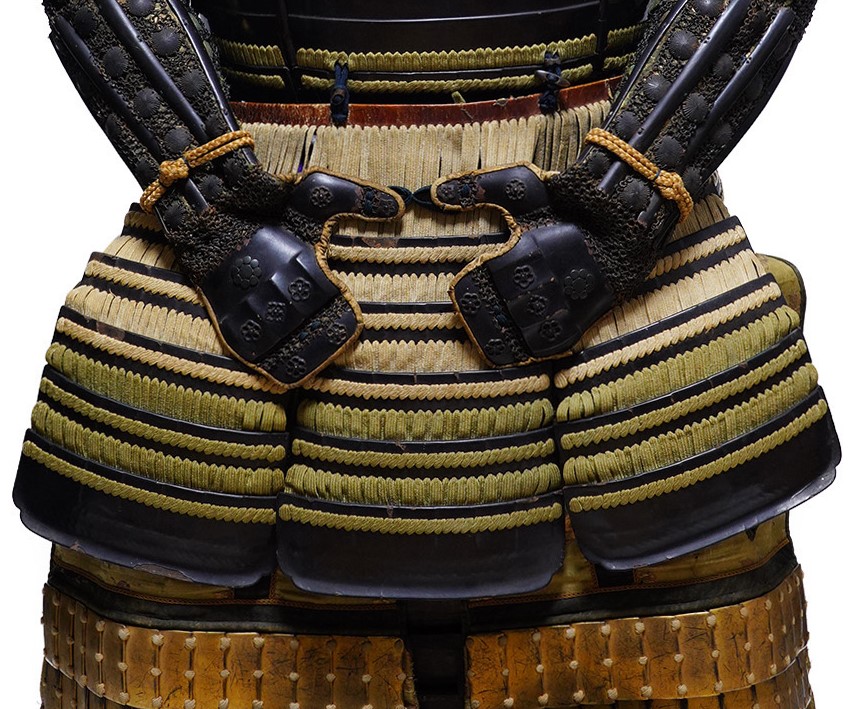
Small parts
■Kote (armored sleeves):
Intricate iron chain mail with silk.
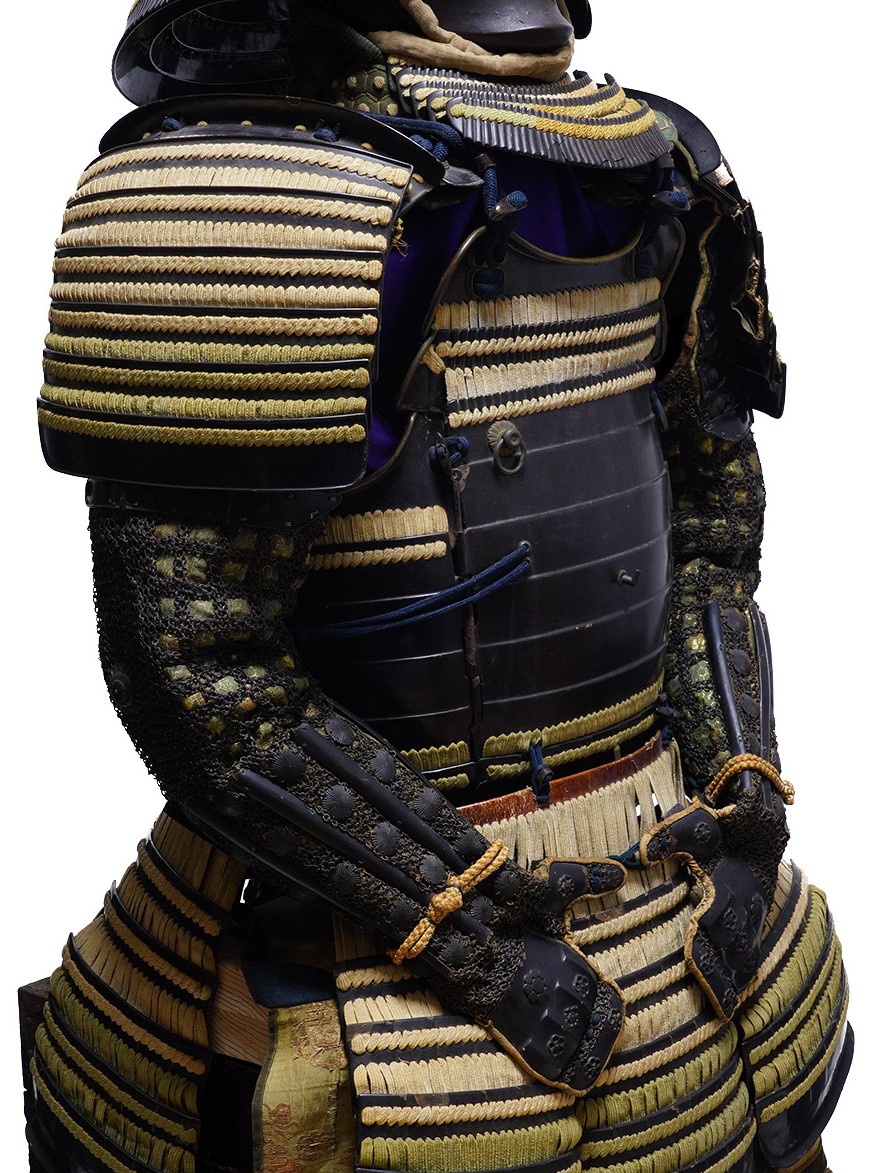
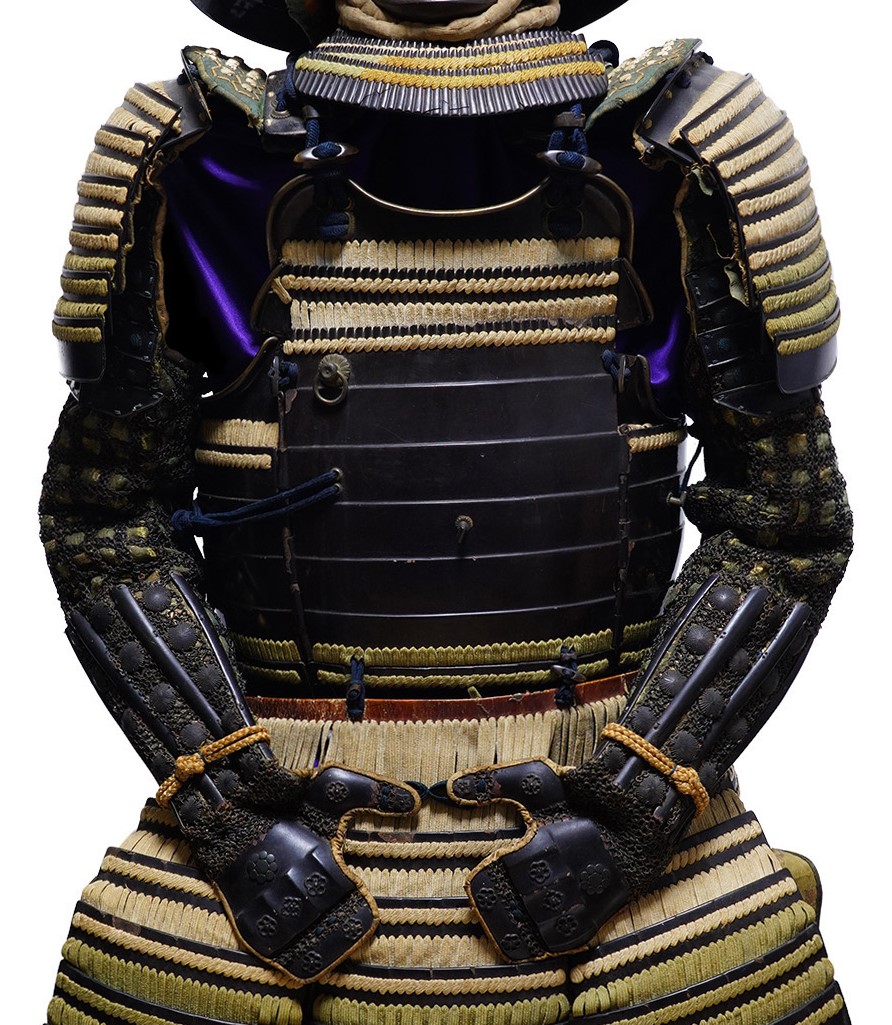
■Haidate (thigh protection):
The Haidate (佩楯) is a thigh guard. Many small rectangular plates are tied together with threads. The golden color of these plates adds decorativeness to this armor.

■Suneate (shin guard):
The Kikkou (亀甲, turtle’s shell) pattern is used for the cloth of the Suneate (脛当). It is a continuous geometric pattern connecting regular hexagons up and down. A theory says that this design was brought from China and the Korean Peninsula during the Asuka (飛鳥, 592-710) and Nara (奈良, 710-794) periods. A proverb says turtles live long lives; therefore, turtle and turtle shell patterns represent longevity. In addition, as this continuous hexagonal pattern does not get out of its shape, it is said people wished for eternal prosperity by using this design.
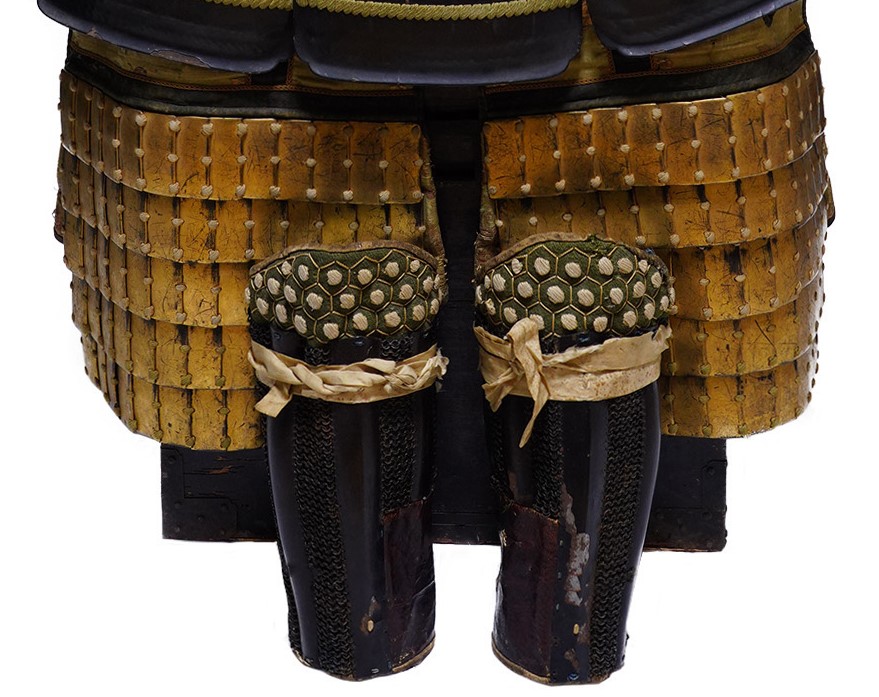
■Gattari (Sashimono holder), Uketsutsu/Sashidutsu (supporter, tube):
If you focus on the back of this armor, you will find that a square-shaped metal frame is attached. It is a gear called the Gattari (合当理) that supports the upper part of the Sashimono (指物, a frag or decorative sign installed at the back of armor). And the Uketsutsu (受筒)/ Sashidutsu (指筒) is a tube to store a Sashimono. Samurai warriors judged their sides and enemies on the battlefields by checking the motifs designed for flags. Especially in group battles with infantry, this method was very effective because they could instantly identify affiliations.
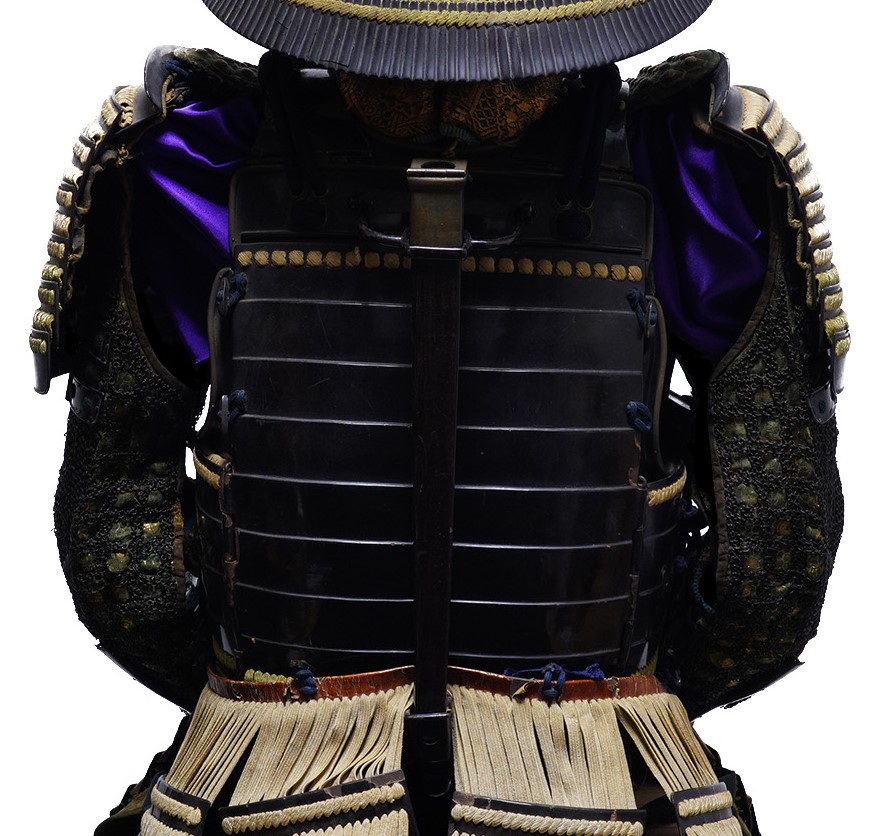
■Gunsen (fan):
A Gunsen (軍扇) is included in this item. It is a fan used by feudal loads to take commands on battlefields and to motivate their soldiers. As seen on this fan, the Jitsu Getsu Seishin (日月星辰, generic name for the sun, moon, stars, and sky) has often been designed on Gunsens. 日 means the sun, 月 means the moon, and 星辰 means star, constellation. There are several rules for the design and materials of Gunsen. For example, the Oyabone (親骨, two thickest bones on the outside of the fan) has a wide width. And this Oyabone has to be made of the Shougun Boku (将軍木, another name for Aphananthe aspera), etcetera. The size of this fan also has detailed rules. There was even a rule that when a new Gunsen was made, it had to be performed incantation and players. Unlike ordinary fans, which are used on a daily basis, Gunsens were regarded as highly solemn tools. We surmise that it is related to the fact that this Gunsen was not simply used as a commanding tool but was also used to pray for victory in battle under the protection of the gods and Buddha. We would say that the Gunsen is one of the weapons that stayed with the Samurai warriors on battlefields.
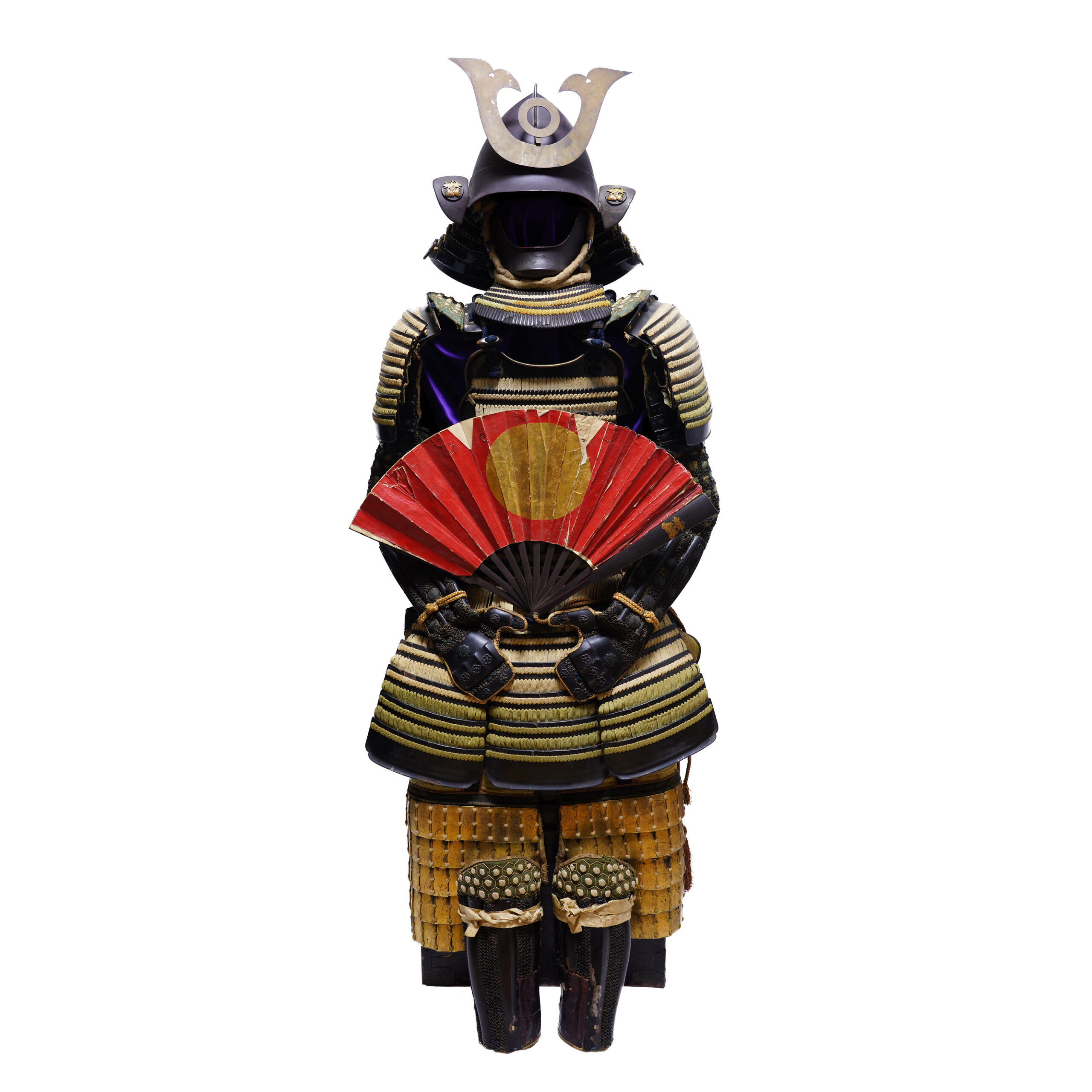
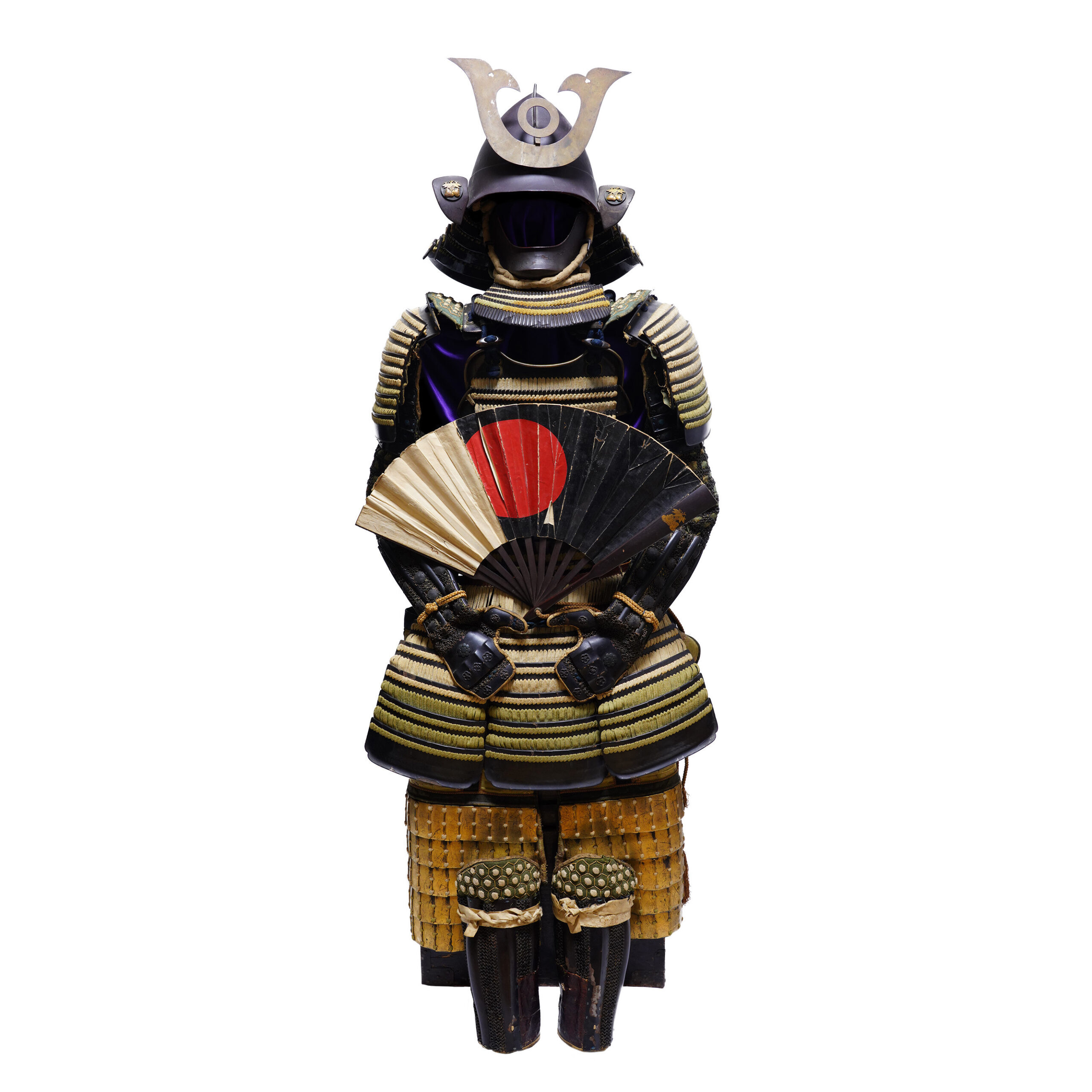
Certification: Tokubetsu Kicho Shiryo Certificate (No.2038)
On May 14th 2023, this armor was appraised as a Tokubetsu Kicho Shiryo by The Association for the Research and Preservation of Japanese Helmets and Armor, which is the most trusted Japanese armor appraiser in Japan. This association is also known as Nihon Katchu Bugu Kenkyu Hozonkai (日本甲冑武具研究保存会). Tokubestu Kicho Shiryo (特別貴重資料) means special rare article. It is ranked as the third highest of five rankings.
The paper mentions the armor was made in the mid Edo period (late 17th- early 18th century). You can receive this original authentication paper.
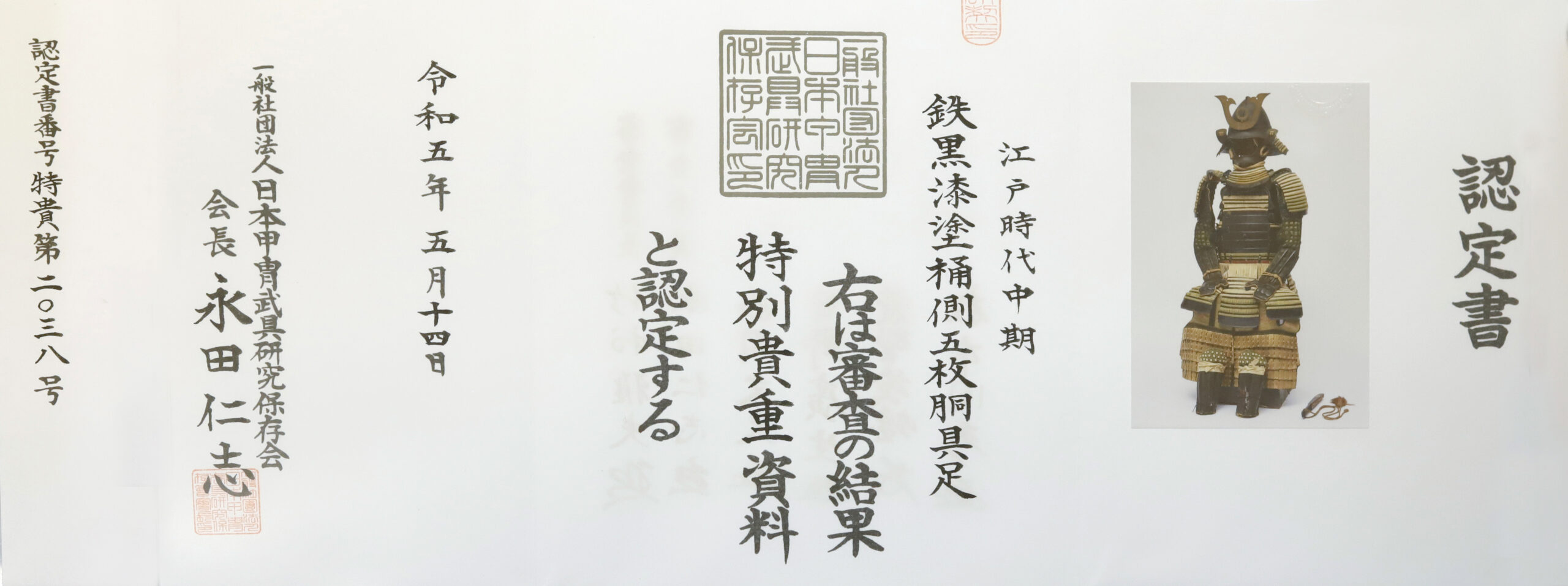
An English translation of the certificate is available on request. We won’t charge any additional fee.
【About us】
Samurai Museum is located in Tokyo, Japan, exhibiting antique artifacts related to the Samurai history. Samurai Museum Shop is the place for those who are interested in Japanese culture and craftsmanship. We deal with antique Samurai swords/armor, traditional crafts made in Japan and so on.
【Antique Japanese Armor and Export process】
After receiving the full payment from you, we will apply for its export permit from the agency for Cultural Affairs to legally export the antique Samurai armor to other countries. It normally takes around 2-4 weeks to receive this permit. And we would like you to expect at least 1-1.5 months for your order to arrive at your given address after you ordered.
【Payment method】
We accept payment through Stripe (Credit card), PayPal, Apple Pay or ChromePay, all of which are secure payment methods. Also, you don’t need to make an account on Stripe for the checkout. If you prefer other payment method, please contact us. You may either pay in JPY, USD, AUD, CAD, EUR, CHF or GBP. The price is set in Japanese Yen. Prices in other currencies are automatically calculated based on the latest exchange rate.

【Shipping duration】
We normally ship via EMS (Express Mail Service) provided by Japan Post. It usually takes at least 5-14 days to deliver the package after you place an order. We offer Free International Shipping as long as we can ship your order by EMS. If you prefer other shipping carriers, please contact us.
We will inform you of the order’s tracking number via email. Please make sure you fill out your valid email address correctly.
*Please keep in mind that due to the spread of COVID-19, there might be possible delays in delivery. If you like to make sure if EMS shipping is available to your country, please contact us.

【How to make sure the condition】
Please keep in mind that what you are going to purchase is an antique item. We uploaded high resolution photos for you to check its condition thoroughly. If you like to see more photos with different angles, please feel free to contact us. We will be happy to send them to you so that you can make informed decision. It is essential for us to know that you are happy with your choice of a sword. and we are prepared to use the best of our ability to serve you.
【How To Contact Us】
Please contact us through email, Facebook Messenger or Live Chat if you have any questions. You can find each icon on the right side of the website. Please click one of them to reach us. We will reply to you within 1-2 business days.
【How To Preserve Antique Samurai Armor】
Dryness, humidity, and bad ventilation might deteriorate the condition of antique Samurai armor. The best temperature to preserve Samurai armor is around 20℃ in Celsius, and humidity should be about 60%. Direct sunlight should be avoided. We recommend storing armors in a room with good ventilation. If you like to display them outside the boxes for a prolonged time, we suggest using a glass case in order for dust not to be accumulated easily. In case you don’t use a glass case, please make sure to regularly dust off from the armor by using a soft brush made of delicate cloth or brush for painting.
If you like to know more about the preservation of this armor, please feel free to contact us.

